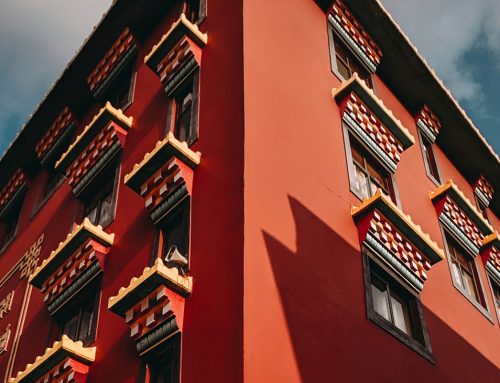Sustainable design working in harmony with resident needs and lifestyles
Affordable buildings in India are designed for the ideal man – think Brad Pitt or Bollywood’s biggest star, Shah Rukh Khan; and that’s a problem according to Kriti Agarwal. It means most of the people living in them are overlooked, neglected or under-represented.
Ms Agarwal is the Founder and CEO of the Centre for Empathic Urbanism and worked with GBPN on a project that aimed to to improve urban design standards in India.
 “Our buildings are designed based on the idea of the ‘ideal man’ and the ‘able body’ but this doesn’t exist. Nobody is perfectly fit all the time. If you have a cold or an injury or you’re elderly or pregnant, your physical ability will be impaired – but the building design doesn’t take that into account,” Ms Agarwal said.
“Our buildings are designed based on the idea of the ‘ideal man’ and the ‘able body’ but this doesn’t exist. Nobody is perfectly fit all the time. If you have a cold or an injury or you’re elderly or pregnant, your physical ability will be impaired – but the building design doesn’t take that into account,” Ms Agarwal said.
“With affordable building developments, we’re talking about people from resource poor backgrounds whose growth may be stunted by poor nutrition, who have reduced access to sanitation and healthcare infrastructure and are marginalised by their location in the less desirable parts of the city. We’re talking about women, children, the elderly and people with disabilities.
“We are not building homes for ideal men so why are we designing homes based on those standards?”
Ms Agarwal said some of the buildings the team had inspected required residents to walk long distances or were up to four storeys high with no elevator.
“Can you imagine if you’re an elderly person with arthritis, or a mother, or if you’re a child with a broken leg needing to go to school and you’re living on the fourth floor?” she said.
“You will avoid going out and combine four or five tasks into one so you can get them over with and only have to make that trip once. As a result of this, you’ll be isolated and have restricted mobility – further limiting your access to resources.”
Ms Agarwal said understanding the actual needs of the diverse groups of people inhabiting the buildings was an important first step to ensuring that India’s sustainable building guidelines were adding value to their lives.
Ms Agarwal, along with a team including Ashok B Lall Architects, worked to assess the Housing and Urban Development Policy in India and provide updated guidelines that they hope will see building standards change. No longer will an ‘ideal man’ be the benchmark for decision-making. Instead, the unique challenges and needs of a diverse range of actual residents will form the basis of recommendations.
The project explored better ways to design and build ‘healthy’ and ‘affordable’ sustainable homes. As part of the process, Ms Agarwal, consulted directly with residents and conducted an analysis of existing housing challenges.
The findings from these consultations will be presented to the Indian government to help inform the impending changes of the National Building Code of India earmarked for 2025.
Better for the planet, better for people
Designing buildings to be resilient to changing climate will make them more livable for people too, according to GBPN’s Senior Advisor, India, Gautam Nagar.
“We already have some evidence to demonstrate that sustainable buildings have benefits for the health of residents as well as the environment, so we incorporated that research into this activity,’ Mr Nagar said.
Part of the work the team undertook in India was to conduct research exploring better ways to design and build healthy affordable sustainable homes. The project findings were intended to support improved standards in indoor and outdoor environmental quality, especially for poorer communities.

According to Ashok B Lall, from Ashok B Lall Architects, designing a purely environmentally sustainable building is not enough, the neighbourhood must also be a primary consideration. He said taking a holistic approach helped ensure that recommendations in support of sustainable home design were not undermined by user behaviour.
“For example, we know well placed windows provide natural lighting and ventilation and help regulate comfortable air temperatures. But we also know that people close the windows because of dust, pests, noise, moisture, poor quality views or fears about safety and security,” Mr Lall said.
“If they close their windows, they will turn on their lights and may resort to air conditioning and suddenly the carbon footprint of that building increases dramatically and any sustainable design benefits are overridden by human behaviour.
“This is why, in this project, we are starting with understanding human behaviour and lifestyle to guide the bye-laws and not vice-versa.”
Overcoming developer fears about cost
GBPN’s Senior Advisor, India, Gautum Nagar, said that part of the challenge in creating real change was helping developers understand that sustainable design doesn’t have to cost more than conventional practices.
 “The reality is, there are lots of very simple adjustments that can be made at the design stage to make a building more sustainable and energy efficient,” Mr Nagar said.
“The reality is, there are lots of very simple adjustments that can be made at the design stage to make a building more sustainable and energy efficient,” Mr Nagar said.
Mr Ashok Lall, the lead architect on the research project agreed.
“One of the great benefits is that the financial side is usually not difficult to sell because when you use sustainable design strategically, the buildings become more affordable across virtually all metrics,” he said.
Positively influencing future building policy of India
This research comes at a time that has the potential to make meaningful changes to the way developers think about affordable residential projects in India into the future.
“Our goal is for the findings to be incorporated into the new National Building Code guidelines in 2025. These are updated once per decade, so opportunities like this do not come along very often,” said Mr Nagar.
“We expect that 40% of India’s population will be urban by 2030 – which is a huge increase from the current 30%. This means there will be a huge spike in demand for infrastructure and housing. If we act now, we have an opportunity to make sure that the new housing is sustainable, reducing the burden of carbon emissions so we can keep global warming at or below 2%.”
The research was peer-reviewed by a group of local experts ahead of the recommendations being provided to the Indian government.
| Project Name: Healthy Affordable Homes for All, Phase 1 | |
|---|---|
| Goal: | To explore better ways to design and build ‘healthy’ and ‘affordable’ sustainable homes in India and make recommendations to the government to feed into the building code revision process. |
| Funded by: |  |
| Duration: | Jun 2021 – Aug 2022 (14 months) |
| Location: | India |
| Level of Government: | National |
| Reports and Links: |
|
| Government Partner/s: | |
| Research Partners: | 
|
| Implementation Partners: | Indian Institute of Public Health Gandhinagar (IIPHG)
Centre for Empathic Urbanism |
| Advocacy Allies: | None |
| GBPN Experts: | Ashok Behari Lall
Anukriti Pathak Pooja Shukla Dr. Poornima Prabhakaran Gaurav Preshad Tarun Garg |
| Related Project/s: | |





